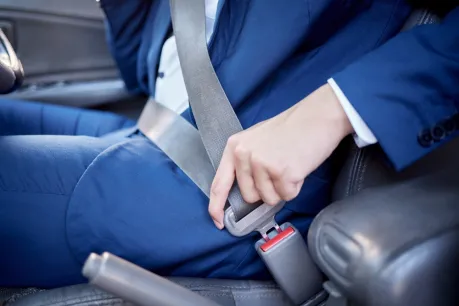The Evolution of Seat Belts: From Inception to Modern-Day Innovations

Injured?
Be their hero behind the wheel. Hear John Morgan’s powerful message on safe driving—click here to watch.
It’s hard to imagine getting into a car without buckling your seat belt. In fact, it feels almost instinctual, and if not, your vehicle’s constant chiming will certainly jog your memory to buckle up.
But seat belts, as we know them today, weren’t always a standard feature in vehicles. The journey of this simple yet life-saving device is fascinating and filled with engineering ingenuity, legal battles, and innovative strides that continue to evolve car safety.
A Humble Beginning: The Early Days of Seat Belts
Seat belts might seem like a no-brainer now, but they weren’t always an essential part of car design. The first patent for a rudimentary seat belt was issued in 1885—even before cars were common—by Edward J. Claghorn. But this early invention was more like a strap that kept passengers from falling out of their seats in carriages.
Fast forward to the early 20th century, and cars were becoming a common mode of transportation. However, car crashes were also becoming more frequent and deadly. It wasn’t until the 1950s that the idea of seat belts as a life-saving tool gained serious momentum, thanks to Swedish engineer Nils Bohlin.
Bohlin, who worked for Volvo, introduced the world to the three-point seat belt in 1959—a design still used today. Unlike previous versions, Bohlin’s design secured both the upper and lower body, distributing force more evenly across the chest and pelvis in the event of an accident. His invention is often credited with saving millions of lives, making it one of the most important safety features in modern cars.
Seat Belts Go Mainstream: The 1960s and 1970s
Despite the groundbreaking three-point seat belt, it took a while for the world to catch on. Seat belts didn’t become a standard feature in cars until the 1960s, when U.S. automakers began offering them as optional equipment.
But one stubborn lawyer fought to make seatbelts mandatory. Attorney and activist Ralph Nader became the face of automotive safety through his 1965 book, Unsafe at Any Speed: The Designed-In Dangers of the American Automobile. The book was a critique of automobile manufacturers and the occupant safety of their vehicles. Nader levied criticisms across the entire industry for vehicle crash-worthiness, the automobile’s effect on air pollution, and stubbornness by many manufacturers to introduce new safety features that might compromise style. The title itself takes aim at the automobile industry’s lack of accountability, blaming the high number of vehicular deaths due to speeding and unsafe driving habits. The book took particular issue with Chevrolet’s Corvair, a rear-engine mid-size sedan, whose tricky handling had resulted in numerous crashes and over 100 lawsuits against General Motors.
Some automakers attempted to downplay Nader’s claims, but by the spring of 1966, Unsafe at Any Speed was a best seller in nonfiction. The publicity Nader’s book generated for automotive safety prompted legislation to create the National Highway Traffic Safety Administration (NHTSA), an agency devoted to saving lives by reducing the number and severity of vehicle-related crashes, and pass the National Traffic and Motor Vehicle Safety Act, requiring all new cars to be fitted with seat belts starting in 1968.
But here’s the kicker: Even though seat belts were now required, wearing them wasn’t. Many drivers and passengers still didn’t use seat belts regularly—some even saw them as an inconvenience. It wasn’t until the 1980s that states started passing seat belt laws, making it mandatory to buckle up.
Fun fact for proud New Yorkers: New York became the first state to enact a seat belt law in 1984. Today, all 50 states have some form of seat belt law, though the specific regulations vary.
The Era of Innovations: Airbags, Pretensioners, and More
As car safety became a top priority, seat belts evolved beyond just a strap across your body. Engineers and automakers worked tirelessly to make them more effective.
In the 1990s, we saw the rise of seat belt pretensioners—a game-changing innovation that works in conjunction with airbags. In the event of a collision, pretensioners automatically tighten the seat belt to remove any slack, keeping passengers securely in place.
Airbags were introduced in the 1970s but became widespread in the 1990s, revolutionizing car safety. However, it’s important to note that airbags alone are not enough to protect you in a crash. Seat belts remain the primary defense mechanism, with airbags serving as a secondary layer of protection. The dynamic duo of airbags and seat belts dramatically reduces the risk of serious injury or death in car accidents.
Modern-Day Seat Belt Innovations: What’s New?
As technology continues to advance, so do seat belts. Today’s seat belts are smarter, stronger, and more responsive than ever.
Load Limiters: These clever mechanisms release a bit of tension from the seat belt during a crash to prevent excessive force on the chest, reducing the risk of injury.
Inflatable Seat Belts: A relatively new feature, these seat belts deploy like an airbag during a crash, providing extra cushioning and reducing the risk of injury, especially for rear-seat passengers.
Seat Belt Reminder Systems: While these might seem annoying when they beep incessantly, seat belt reminders are a simple yet effective tool to ensure everyone in the car is buckled up.
Smart Seat Belts: In development are smart seat belts that work with other car systems to adjust tension based on speed, driving conditions, and potential crash detection. These seat belts may soon interact with the car’s braking and sensor systems to provide maximum protection in real time.
The Future of Seat Belts: What’s Next?
As we look to the future, seat belts will continue to play a vital role in car safety. With the rise of autonomous vehicles and self-driving technology, the design of seat belts may shift to accommodate new seating arrangements and in-car activities. However, experts agree that, regardless of the driving technology, seat belts will remain a crucial component of occupant protection.
We can also expect to see more integration of artificial intelligence (AI) and machine learning in seat belt systems. These advanced systems could automatically adjust seat belts based on a passenger’s size, weight, and position, offering personalized protection in the event of a crash.
Do We Still Need Seat Belts?
Some might argue that with all these new technologies like automatic emergency braking and lane departure warnings, seat belts are less necessary. But that’s far from the truth.
The reality is that no matter how advanced cars become, seat belts remain the most effective tool for preventing serious injury or death in a crash. According to the National Highway Traffic Safety Administration (NHTSA), seat belts reduce the risk of death by 45% for front-seat passengers and serious injury by 50%.
Morgan & Morgan Is Here to Help
From their humble beginnings to the high-tech innovations of today, seat belts have come a long way—and they’re not going anywhere. They remain one of the simplest and most effective ways to protect yourself on the road.
At Morgan & Morgan, we understand the importance of safety and are here to help if you’ve been injured in a car accident. Whether it’s ensuring justice or helping with insurance claims, we’ve got your back. Consider us strapped in next to you as your faithful co-pilots.
So next time you get in the car, remember: Buckle up—it’s the law, and it just might save your life. And as your child’s role model and ultimate superhero, setting a good example will lead them to use the next generation of seatbelts when they finally get behind the wheel.

We've got your back
Injured?
Not sure what to do next?
We'll guide you through everything you need to know.